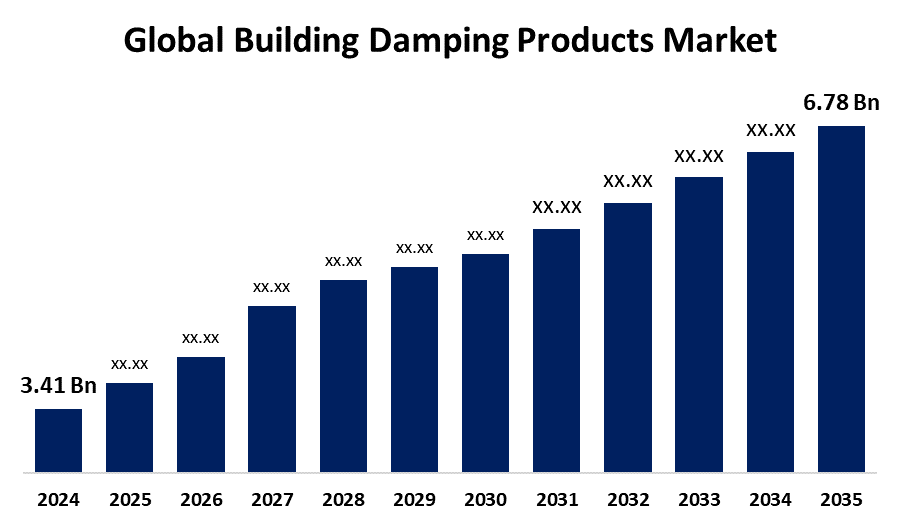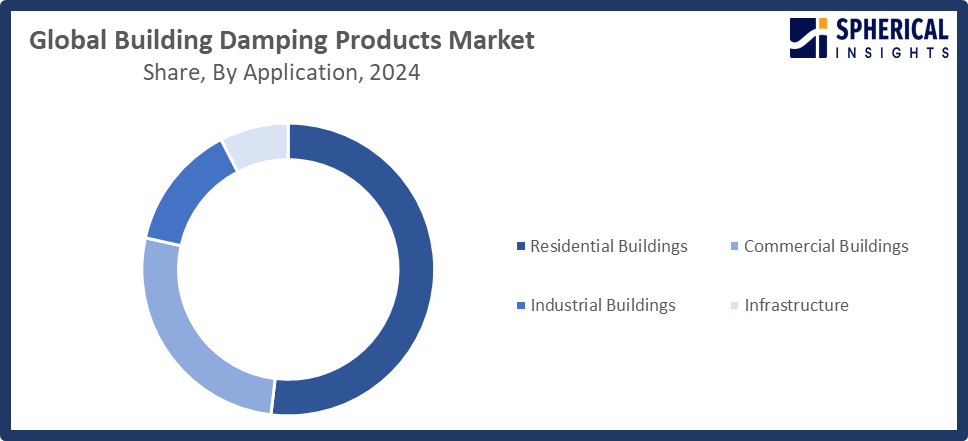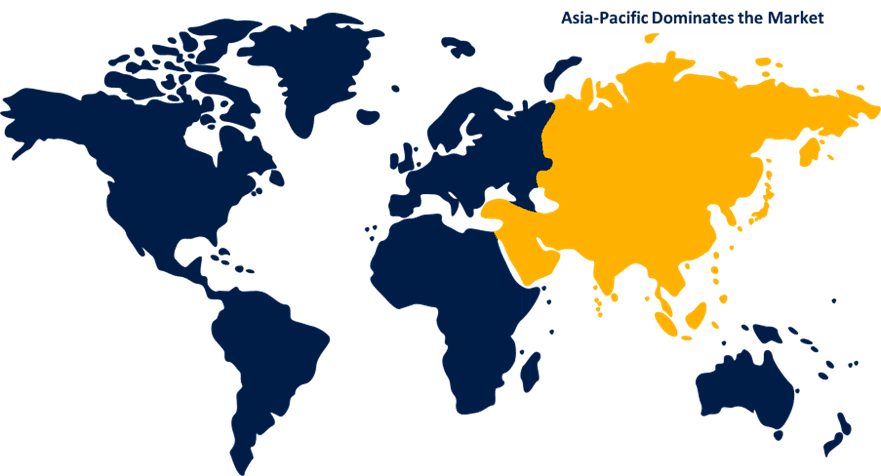Global Building Damping Products Market Size, Share, and COVID-19 Impact Analysis, By Product Type (Viscoelastic Damping Products, Tuned Mass Dampers, Base Isolators, and Others), By Application (Residential Buildings, Commercial Buildings, Industrial Buildings, and Infrastructure), By Region (North America, Europe, Asia-Pacific, Latin America, Middle East, and Africa), Analysis and Forecast 2025 - 2035
Industry: Construction & ManufacturingGlobal Building Damping Products Market Size Insights Forecasts to 2035
- The Global Building Damping Products Market Size Was Estimated at USD 3.41 Billion in 2024
- The Market Size is Expected to Grow at a CAGR of around 6.45% from 2025 to 2035
- The Worldwide Building Damping Products Market Size is Expected to Reach USD 6.78 Billion by 2035
- North America is expected to Grow the fastest during the forecast period.

Get more details on this report -
According to a Research Report Published by Spherical Insights and Consulting, The Global Building Damping Products Market Size was worth around USD 3.41 Billion in 2024, Growing to 3.60 Billion in 2025, and is predicted to Grow to around USD 6.78 Billion by 2035 with a compound annual growth rate (CAGR) of 6.45% from 2025 to 2035. The opportunities for improving building performance and safety are being created by the incorporation of smart technology, such as sensors and the Internet of Things, into dampening systems. Real-time monitoring and damping solution adjustment present a substantial opportunity to increase building efficiency and resilience.
Global Building Damping Products Market Forecast and Revenue Size
- 2024 Market Size: USD 3.41 Billion
- 2025 Market Size: USD 3.60 Billion
- 2035 Projected Market Size: USD 6.78 Billion
- CAGR (2025-2035): 6.45%
- Asia Pacific: Largest market in 2024
- North America: Fastest growing market
Market Overview
The sector centered on the creation, production, and distribution of tools and materials intended to lessen structural vibrations and improve building stability, especially during seismic activity or high wind conditions, is known as the "building damping products market." The building damping products market for building damping products is centered on innovations that improve seismic resilience, lessen structural vibrations, and adhere to changing building codes to guarantee construction safety, stability, and business continuity. The U.S. government's 2025 Earthquake Resilience Act (H.R. 2568), launched in April 2025 to mandate resilience risk assessments, and the reauthorization of the National Earthquake Hazards Reduction Program (NEHRP) via S. 320 in June 2025, federal initiatives emphasize building damping products for retrofitting and new builds. Growing urbanization, the demand for earthquake-resistant construction, and the increased emphasis on raising building safety requirements are the main factors driving the building damping products market. The growing frequency of natural disasters and seismic activity worldwide is one of the main drivers of the building damping products market's expansion.
Key Market Insights
- Asia Pacific is expected to account for the largest share in the building damping products market during the forecast period.
- In terms of product type, the viscoelastic damping products segment is projected to lead the building damping products market throughout the forecast period
- In terms of application, the residential buildings segment captured the largest portion of the market
Building Damping Products Market Trends
- Increased knowledge of how structural protection might save money over the long run
- Seismic dampening systems are increasingly being used in earthquake-prone areas.
- Performance-based seismic design (PBSD) is becoming more and more popular.
- Introducing dampening materials in renovation and retrofit projects
- Developments in intelligent and flexible dampening systems
Report Coverage
This research report categorizes the building damping products market based on various segments and regions, forecasts revenue growth, and analyzes trends in each submarket. The report analyzes the key growth drivers, opportunities, and challenges influencing the building damping products market. Recent market developments and competitive strategies, such as expansion, type launch, development, partnership, merger, and acquisition, have been included to draw the competitive landscape in the market. The report strategically identifies and profiles the key market players and analyzes their core competencies in each sub-segment of the building damping products market.
Global Building Damping Products Market Report Coverage
| Report Coverage | Details |
|---|---|
| Base Year: | 2024 |
| Market Size in 2024: | USD 3.41 Billion |
| Forecast Period: | 2025-2035 |
| Forecast Period CAGR 2025-2035 : | 6.45% |
| 2035 Value Projection: | USD 3.60 Billion |
| Historical Data for: | 2020-2023 |
| No. of Pages: | 146 |
| Tables, Charts & Figures: | 130 |
| Segments covered: | By Product Type, By Application and COVID-19 Impact Analysis |
| Companies covered:: | Maurer SE, Enidine Inc., Trelleborg AB, Oiles Corporation, FIP Industriale S.p.A., VSL International Ltd., Bridgestone Corporation, Kawakin Holdings Co., Ltd., Kinetics Noise Control, Inc., Yokohama Rubber Co., Ltd., Tokyo Fabric Industry Co., Ltd., Dynamic Isolation Systems, Inc., Sumitomo Riko Company Limited, Earthquake Protection Systems, Inc., and others |
| Pitfalls & Challenges: | COVID-19 Impact, Challenges, Future, Growth, & Analysis |
Get more details on this report -
Driving factors:
The demand for efficient damping solutions has increased dramatically as a result of increased awareness and strict building rules put in place to safeguard lives and assets. Additionally, the market is expanding due to the continuous technological developments in damping materials and products, which are improving their effectiveness, affordability, and simplicity of installation. Another important factor propelling the market for building damping products is the growing focus on creating smart cities. Additionally, the market for building damping products is growing in a favorable environment driven by the quickening pace of industrialization and urbanization, especially in emerging economies.
Restraining Factors:
High installation and maintenance costs, low awareness in emerging markets, intricate technical specifications, and erratic regulatory norms that hinder consistent adoption throughout international construction sectors are the key factors restricting the building damping products market.
Market Segmentation
The global building damping products market is divided into product type and application.
Global Building Damping Products Market, By Product Type:
Which types of buildings typically require viscoelastic damping systems?
The viscoelastic damping products segment led the Building Damping Products market, generating the largest revenue share. Viscoelastic damping products are widely used because of their efficient energy absorption and dissipation capabilities. In buildings that need vibration control, including those close to industrial sectors or transportation hubs, such devices are frequently utilized.
The tuned mass dampers segment in the building damping products market is expected to grow at the fastest CAGR over the forecast period. The market for building dampening devices includes tuned mass dampers (TMDs), which are well-known for their ability to effectively reduce vibrations in big buildings like bridges and skyscrapers.
Global Building Damping Products Market, By Application:
What is driving the increased application of damping products in residential buildings?
The residential buildings segment held the largest market share in the Building Damping Products market. The increasing focus on comfort and safety in urban living areas has led to a large application area for dampening products in residential buildings. Growth in this market is also being driven by developers' and homeowners' growing knowledge of the advantages of damping devices, which are aimed at improving safety and living conditions.

Get more details on this report -
The commercial buildings segment in the building damping products market is expected to grow at the fastest CAGR over the forecast period. A trend toward sustainable building methods is also being seen in commercial buildings, where dampening products that improve energy efficiency and lessen environmental effect are being used.
Regional Segment Analysis of the Global Building Damping Products Market
- North America (U.S., Canada, Mexico)
- Europe (Germany, France, U.K., Italy, Spain, Rest of Europe)
- Asia-Pacific (China, Japan, India, Rest of APAC)
- South America (Brazil and the Rest of South America)
- The Middle East and Africa (UAE, South Africa, Rest of MEA)
Asia Pacific Building Damping Products Market Trends

Get more details on this report -
How do government programs in the Asia Pacific region support the growth of the building damping products market?
Rapid urbanization, seismic threats in nations like China and Japan, and significant infrastructure investments are the main drivers of the Asia Pacific region. The Asia Pacific market is expanding due to government initiatives aimed at enhancing building safety and resilience, as well as increasing infrastructure and construction expenditures. The surge in high-tower construction and strict seismic building regulations is predicted to maintain this dominance and indicate a healthy market.
What is the primary purpose of building damping products in construction in China?
The China building damping products market includes sophisticated engineering solutions designed to reduce seismic vibrations, wind-induced oscillations, and structural fatigue in buildings and infrastructure, such as base isolators, tuned mass dampers, viscous dampers, and viscoelastic devices. China supports high-rise urbanization and infrastructure construction despite the country's significant seismic hazards in regions such as Sichuan and Yunnan.
What is the primary focus of Japan’s building damping products market?
The market for building damping products in Japan includes sophisticated engineering solutions for reducing seismic and wind-induced vibrations in structures, including base isolators, viscous dampers, and tuned mass dampers. In Japan's seismically active areas, such as Tokyo and Osaka, these solutions improve building resilience, save lives, and lessen financial losses.
North America Building Damping Products Market Trends
What types of building damping products are used in North America to enhance structural resilience?
The market for building damping products in North America includes cutting-edge engineering systems like base isolators, tuned mass dampers, viscous dampers, and viscoelastic devices that are designed to absorb seismic energy, reduce earthquake and wind vibrations, and strengthen structural resilience in high-risk areas like Canada's Cascadia Subduction Zone and California's San Andreas Fault. North America continues to be a major market for damping products due to its strict building requirements and strong awareness of safety standards.
What types of building damping products are commonly used in the US market?
The market for building damping products in the US includes tuned mass dampers, base isolators, and viscous dampers. These products are intended to reduce wind and seismic vibrations and improve structural resilience in high-risk regions such as California. The NEHRP Reauthorization Act of 2024 (S.3606) provides $100.9 million for seismic renovations, with a focus on damping in accordance with ASCE/SEI 7-22 guidelines.
What types of building damping products are included in the Canada market?
The Canada Building Damping Products Market includes tuned mass dampers, base isolators, and viscoelastic dampers, which are designed to disperse seismic and wind-induced vibrations and support structural integrity in high-risk areas such as the Yukon and British Columbia.
Competitive Analysis:
The report offers the appropriate analysis of the key organizations/companies involved within the global building damping products market, along with a comparative evaluation primarily based on their type of offering, business overviews, geographic presence, enterprise strategies, segment market share, and SWOT analysis. The report also provides an elaborate analysis focusing on the current news and developments of the companies, which includes type development, innovations, joint ventures, partnerships, mergers & acquisitions, strategic alliances, and others. This allows for the evaluation of the overall competition within the market.
Worldwide Top Key Players in The Building Damping Products Market Include
- Maurer SE
- Enidine Inc.
- Trelleborg AB
- Oiles Corporation
- FIP Industriale S.p.A.
- VSL International Ltd.
- Bridgestone Corporation
- Kawakin Holdings Co., Ltd.
- Kinetics Noise Control, Inc.
- Yokohama Rubber Co., Ltd.
- Tokyo Fabric Industry Co., Ltd.
- Dynamic Isolation Systems, Inc.
- Sumitomo Riko Company Limited
- Earthquake Protection Systems, Inc.
- Others
Recent Development
- In January 2025, Toray Industries launched an advanced damping nylon resin designed for building high-performance damping products. Offering four times the damping performance of butyl rubber while retaining nylon’s rigidity and moldability, the material is now being sampled to customers to enhance comfort in electric and autonomous vehicle components.
Key Target Audience
- Market Players
- Investors
- End-users
- Government Authorities
- Consulting And Research Firm
- Venture capitalists
- Value-Added Resellers (VARs)
Market Segment
This study forecasts revenue at the global, regional, and country levels from 2020 to 2035. Spherical Insights has segmented the building damping products market based on the following segments:
Global Building Damping Products Market, By Product Type
- Viscoelastic Damping Products
- Tuned Mass Dampers
- Base Isolators
- Others
Global Building Damping Products Market, By Application
- Residential Buildings
- Commercial Buildings
- Industrial Buildings
- Infrastructure
Global Building Damping Products Market, By Regional Analysis
- North America
- US
- Canada
- Mexico
- Europe
- Germany
- UK
- France
- Italy
- Spain
- Russia
- Rest of Europe
- Asia Pacific
- China
- Japan
- India
- South Korea
- Australia
- Rest of Asia Pacific
- South America
- Brazil
- Argentina
- Rest of South America
- Middle East & Africa
- UAE
- Saudi Arabia
- Qatar
- South Africa
- Rest of the Middle East & Africa
Frequently Asked Questions (FAQ)
-
1. What is the CAGR of the building damping products market over the forecast period?The global building damping products market is projected to expand at a CAGR of 6.45% during the forecast period.
-
2. What is the market size of the building damping products market?The global building damping products market size is expected to grow from USD 3.41 billion in 2024 to USD 6.78 billion by 2035, at a CAGR 6.45% of during the forecast period 2025-2035.
-
3. Which region holds the largest share of the building damping products market?Asia Pacific is anticipated to hold the largest share of the building damping products market over the predicted timeframe.
-
4. Who are the top companies operating in the global building damping products market?Maurer SE, Enidine Inc., Trelleborg AB, Oiles Corporation, FIP Industriale S.p.A., VSL International Ltd., Bridgestone Corporation, Kawakin Holdings Co., Ltd., Kinetics Noise Control, Inc., Yokohama Rubber Co., Ltd., Tokyo Fabric Industry Co., Ltd., Dynamic Isolation Systems, Inc., Sumitomo Riko Company Limited, Earthquake Protection Systems, Inc., and others.
-
5. What factors are driving the growth of the building damping products market?Increased infrastructure development, expanding seismic awareness, strict construction standards, government initiatives, and the growing demand for resilient, sustainable structures worldwide are some of the factors driving the growth of the building damping products market.
-
6. What are market trends in the building damping products market?Market trends include adoption of advanced seismic damping technologies, integration of smart systems, increased retrofitting activities, stricter building codes, focus on sustainability, and rising investments in urban and infrastructure projects.
-
7. What are the main challenges restricting wider adoption of the building damping products market?High installation costs, a lack of knowledge in emerging areas, complicated technical requirements, uneven legislation, and reluctance to alter conventional construction methods are among the primary challenges preventing wider implementation.
Need help to buy this report?